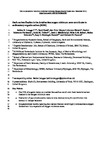Dark carbon fixation in the Arabian Sea oxygen minimum zone contributes to sedimentary organic carbon (SOM)
| dc.contributor.author | Lengger, Sabine | |
| dc.contributor.author | Rush, D | |
| dc.contributor.author | Mayser, JP | |
| dc.contributor.author | Blewett, J | |
| dc.contributor.author | Schwartz‐Narbonne, R | |
| dc.contributor.author | Talbot, HM | |
| dc.contributor.author | Middelburg, JJ | |
| dc.contributor.author | Jetten, MSM | |
| dc.contributor.author | Schouten, S | |
| dc.contributor.author | Sinninghe Damsté, JS | |
| dc.contributor.author | Pancost, RD | |
| dc.date.accessioned | 2020-01-13T19:35:11Z | |
| dc.date.available | 2020-01-13T19:35:11Z | |
| dc.date.issued | 2019-12 | |
| dc.identifier.issn | 0886-6236 | |
| dc.identifier.issn | 1944-9224 | |
| dc.identifier.other | 0 | |
| dc.identifier.uri | http://hdl.handle.net/10026.1/15301 | |
| dc.description | No embargo required. | |
| dc.description.abstract |
In response to rising CO2 concentrations and increasing global sea surface temperatures, oxygen minimum zones (OMZ), or “dead zones”, are expected to expand. OMZs are fueled by high primary productivity, resulting in enhanced biological oxygen demand at depth, subsequent oxygen depletion, and attenuation of remineralization. This results in the deposition of organic carbon-rich sediments. Carbon drawdown is estimated by biogeochemical models; however, a major process is ignored: carbon fixation in the mid- and lower water column. Here, we show that chemoautotrophic carbon fixation is important in the Arabian Sea OMZ; and manifests in a 13C-depleted signature of sedimentary organic carbon. We determined the δ13C values of Corg deposited in close spatial proximity but over a steep bottom-water oxygen gradient, and the δ13C composition of biomarkers of chemoautotrophic bacteria capable of anaerobic ammonia oxidation (anammox). Isotope mixing models show that detritus from anammox bacteria or other chemoautotrophs likely forms a substantial part of the organic matter deposited within the Arabian Sea OMZ (~17%), implying that the contribution of chemoautotrophs to settling organic matter is exported to the sediment. This has implications for the evaluation of past, and future, OMZs: biogeochemical models that operate on the assumption that all sinking organic matter is photosynthetically derived, without new addition of carbon, could significantly underestimate the extent of remineralization. Oxygen demand in oxygen minimum zones could thus be higher than projections suggest, leading to a more intense expansion of OMZs than expected. | |
| dc.format.extent | 1715-1732 | |
| dc.language | en | |
| dc.language.iso | en | |
| dc.publisher | American Geophysical Union (AGU) | |
| dc.subject | Oxygen minimum zones | |
| dc.subject | Carbon cycle | |
| dc.subject | Organic matter | |
| dc.subject | Chemoautotrophy | |
| dc.subject | Anammox | |
| dc.subject | Stable isotopes | |
| dc.title | Dark carbon fixation in the Arabian Sea oxygen minimum zone contributes to sedimentary organic carbon (SOM) | |
| dc.type | journal-article | |
| dc.type | Journal Article | |
| plymouth.author-url | https://www.webofscience.com/api/gateway?GWVersion=2&SrcApp=PARTNER_APP&SrcAuth=LinksAMR&KeyUT=WOS:000502928200001&DestLinkType=FullRecord&DestApp=ALL_WOS&UsrCustomerID=11bb513d99f797142bcfeffcc58ea008 | |
| plymouth.issue | 12 | |
| plymouth.volume | 33 | |
| plymouth.publication-status | Published | |
| plymouth.journal | Global Biogeochemical Cycles | |
| dc.identifier.doi | 10.1029/2019gb006282 | |
| plymouth.organisational-group | /Plymouth | |
| plymouth.organisational-group | /Plymouth/Faculty of Science and Engineering | |
| plymouth.organisational-group | /Plymouth/REF 2021 Researchers by UoA | |
| plymouth.organisational-group | /Plymouth/REF 2021 Researchers by UoA/UoA07 Earth Systems and Environmental Sciences | |
| dcterms.dateAccepted | 2019-11-06 | |
| dc.rights.embargodate | 2020-1-21 | |
| dc.identifier.eissn | 1944-9224 | |
| dc.rights.embargoperiod | Not known | |
| rioxxterms.versionofrecord | 10.1029/2019gb006282 | |
| rioxxterms.licenseref.uri | http://www.rioxx.net/licenses/all-rights-reserved | |
| rioxxterms.licenseref.startdate | 2019-12 | |
| rioxxterms.type | Journal Article/Review |


